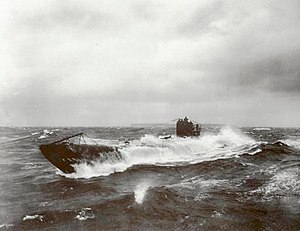SM UB-60
 UB-148 at sea, a U-boat similar to UB-60.
| |
| History | |
|---|---|
| Name | UB-60 |
| Ordered | 20 May 1916[2] |
| Builder | AG Vulcan, Hamburg |
| Cost | 3,279,000 German Papiermark |
| Yard number | 85 |
| Launched | 14 April 1917[1] |
| Commissioned | 6 June 1917[1] |
| Fate | surrendered 26 November 1918; foundered English Channel 12 July 1919 |
| General characteristics [1] | |
| Class and type | German Type UB III submarine |
| Displacement |
|
| Length | 55.52 m (182 ft 2 in) (o/a) |
| Beam | 5.76 m (18 ft 11 in) |
| Draught | 3.70 m (12 ft 2 in) |
| Propulsion |
|
| Speed |
|
| Range |
|
| Test depth | 50 m (160 ft) |
| Complement | 3 officers, 31 men[1] |
| Armament |
|
| Service record | |
| Part of: | Training Flotilla |
| Commanders: |
|
| Operations: | No patrols |
| Victories: | None |
SM UB-60 was a German Type UB III submarine or U-boat in the German Imperial Navy (German: Kaiserliche Marine) during World War I. She was commissioned into the of the German Imperial Navy on 6 June 1917 as SM UB-60.[nb 1]
She operated as part of the based in Kiel. UB-60 was surrendered to the Allies at Harwich on 26 November 1918 in accordance with the requirements of the Armistice with Germany. She was sold by the British Admiralty to George Cohen on 3 March 1919 for £1,850, but foundered in tow en-route from Chatham to Swansea for breaking-up on 12 June 1919.[4]
Construction[]
She was built by AG Vulcan of Hamburg and following just under a year of construction, launched at Hamburg on 14 April 1917. UB-60 was commissioned later that same year under the command of Oblt.z.S. Peter Ernst Eiffe. Like all Type UB III submarines, UB-60 carried 10 torpedoes and was armed with a 8.8 cm (3.46 in) deck gun. UB-60 would carry a crew of up to 3 officer and 31 men and had a cruising range of 8,420 nautical miles (15,590 km; 9,690 mi). UB-60 had a displacement of 508 t (500 long tons) while surfaced and 639 t (629 long tons) when submerged. Her engines enabled her to travel at 13.3 knots (24.6 km/h; 15.3 mph) when surfaced and 8 knots (15 km/h; 9.2 mph) when submerged.
Notes[]
- ^ "SM" stands for "Seiner Majestät" (English: His Majesty's) and combined with the U for Unterseeboot would be translated as His Majesty's Submarine.
References[]
- ^ Jump up to: a b c d Gröner 1991, pp. 25–30.
- ^ Rössler 1979, p. 60.
- ^ Helgason, Guðmundur. "WWI U-boat commanders: Peter Ernst Eiffe". German and Austrian U-boats of World War I - Kaiserliche Marine - Uboat.net. Retrieved 8 March 2015.
- ^ Dodson, Aidan; Cant, Serena (2020). Spoils of War: the fate of enemy fleets after the two World Wars. Barnsley: Seaforth. pp. 24, 96–98, 128. ISBN 978-1-5267-4198-1.
Bibliography[]
- Bendert, Harald (2000). Die UB-Boote der Kaiserlichen Marine, 1914-1918. Einsätze, Erfolge, Schicksal (in German). Hamburg: Verlag E.S. Mittler & Sohn GmbH. ISBN 3-8132-0713-7.
- Gröner, Erich; Jung, Dieter; Maass, Martin (1991). U-boats and Mine Warfare Vessels. German Warships 1815–1945. 2. Translated by Thomas, Keith; Magowan, Rachel. London: Conway Maritime Press. ISBN 0-85177-593-4.
- Rössler, Eberhard (1979). U-Bootbau bis Ende des 1. Weltkrieges, Konstruktionen für das Ausland und die Jahre 1935 - 1945. Die deutschen U-Boote und ihre Werften (in German). I. Munich: Bernard & Graefe. ISBN 3-7637-5213-7.
- German Type UB III submarines
- World War I submarines of Germany
- U-boats commissioned in 1917
- 1917 ships
- Ships built in Hamburg
